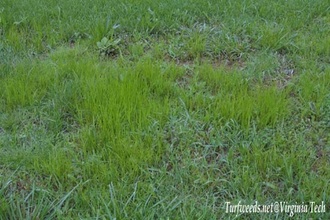Driving Homeowners ‘Nuts – Sedge’ in the Lawn

Related Links
Lots of questions come in to the offices of the VT Turf Team and those of our statewide Virginia Cooperative Extension network alike during the late summer/early fall period regarding ‘grass patches that just can’t be mowed often enough’. Probably 9 times out of 10, those ‘grass’ patches turn out to be patches of nutsedge, with the most prevalent form of this weed in Virginia being yellow nutsedge (Cyperus esculentus L.).
Sedges are easily identified by their triangular stem and overall triangle shape as a plant when peered upon from above (a pdf attachment information and photos on yellow nutsedge taken from VTs Turfweeds.net is linked to this podcast). Sedges are usually indicators of poorly drained soils, but they can compete effectively with turf in just about any soil condition. They emerge in Virginia in June and will remain part of the ground canopy until frost, when they behave much like warm-season grasses and they enter winter dormancy. Yellow nutsedge reproduces and survives by way of rhizomes and tubers. Its tubers are at the end of the rhizome whereas another closely related sedge (purple nutsedge, Cyperus purpureum) has tubers all along its below ground stem. This is one of the reasons that hand-pulling these weeds rarely meets with a great deal of success as a ‘control alternative’ because so much regenerative tissue (i.e. rhizomes and tubers) simply remains below the soil and will emerge again the following June.
There are four primary herbicides available for sedge control in the homeowner market. The active ingredients to look for on the herbicide label are: bentazon, halosulfuron, imazaquin, or sulfentrazone. Of this group, the most recent chemistry that controls the widest spectrum of sedges and another closely related group called the ‘Kyllingas’ is sulfentrazone, but halosulfuron, imazaquin and bentazon have been staples for many years in targeting this weed and other closely related species.
There is still an opportunity to gain appreciable control of sedges in late summer/early fall, but every day closer to a killing frost that an application is delayed is reducing the potential control of the weed by the herbicide. Late in the season the plant begins to concentrate more on producing seed than it does storing carbohydrates in its rhizomes and tubers, and this general change in ‘flow direction’ within the plant means it is harder to get the herbicide to the below-ground survival structures in sufficient quantity to kill the plant entirely. As a rule of thumb, expect nutsedge control even under ideal conditions to require more than a single application. Further information on control is available at the Virginia Cooperative Extension Pest Management Guide for Lawns go to www.vt.edu and search for PMG. Always follow the label directions for any pesticide in order to protect yourself, others, and the environment. And remember that your local extension office is a great resource for information specific to your location.


